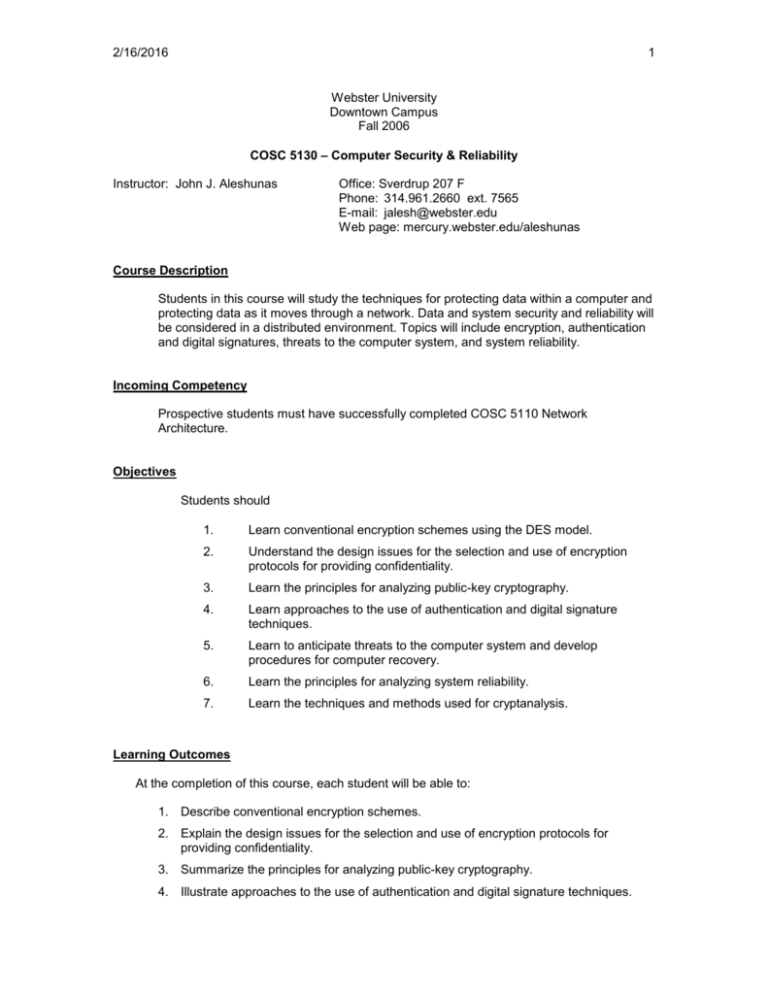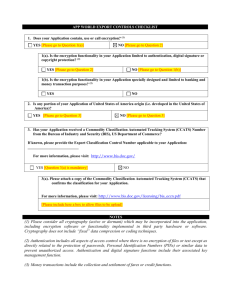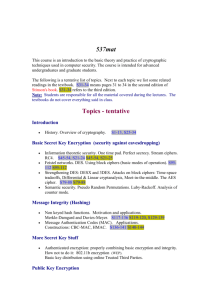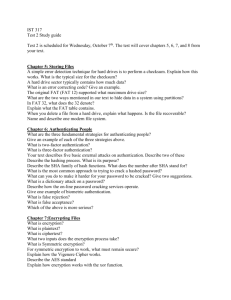COSC 5130 Computer Security and Reliability
advertisement

2/16/2016 1 Webster University Downtown Campus Fall 2006 COSC 5130 – Computer Security & Reliability Instructor: John J. Aleshunas Office: Sverdrup 207 F Phone: 314.961.2660 ext. 7565 E-mail: jalesh@webster.edu Web page: mercury.webster.edu/aleshunas Course Description Students in this course will study the techniques for protecting data within a computer and protecting data as it moves through a network. Data and system security and reliability will be considered in a distributed environment. Topics will include encryption, authentication and digital signatures, threats to the computer system, and system reliability. Incoming Competency Prospective students must have successfully completed COSC 5110 Network Architecture. Objectives Students should 1. Learn conventional encryption schemes using the DES model. 2. Understand the design issues for the selection and use of encryption protocols for providing confidentiality. 3. Learn the principles for analyzing public-key cryptography. 4. Learn approaches to the use of authentication and digital signature techniques. 5. Learn to anticipate threats to the computer system and develop procedures for computer recovery. 6. Learn the principles for analyzing system reliability. 7. Learn the techniques and methods used for cryptanalysis. Learning Outcomes At the completion of this course, each student will be able to: 1. Describe conventional encryption schemes. 2. Explain the design issues for the selection and use of encryption protocols for providing confidentiality. 3. Summarize the principles for analyzing public-key cryptography. 4. Illustrate approaches to the use of authentication and digital signature techniques. 2/16/2016 2 5. Explain how to anticipate threats to the computer system and develop procedures for computer recovery. 6. Describe the principles for analyzing system reliability. 7. Summarize the techniques and methods used for cryptanalysis. Schedule Week 1 Course overview Introduction to computer security and attacks Conventional encryption Classical techniques Steganography Monoalphabetic Ciphers Polyalphabetic Ciphers Transposition Techniques Rotor Machines Modern techniques Simplified DES Block Cipher Principles Differential and Linear Cryptanalysis The Data Encryption Standard The Strength of DES Text: Ch 1 - Overview Ch 2 –Classical Encryption Techniques Ch 3 – Block Ciphers and the Data Encryption Standard Discussion of individual research papers Week 2 The Mathematics of Finite Fields Modular and Polynomial Arithmetic The Advanced Encryption Standard (AES) Triple DES International Data Encryption Algorithm Example Algorithms Characteristics of Advanced Symmetric Block Ciphers Traffic Confidentiality Key Distribution Random Number Generation Text: Week 3 Ch 4 – Finite Fields Ch 5 – Advanced Encryption Standard Ch 6 – More on Symmetric Ciphers Ch 7 – Confidentiality Using Symmetric Encryption Prime and Relatively Prime Numbers Testing for Primality Discrete Logarithms Principles of Public-Key Cryptosystems The RSA Algorithm Diffie-Hellman Key Exchange 2/16/2016 Week 3 (cont.) Week 4 Week 5 3 Text: Exam Authentication Requirements Authentication Functions Hash Functions MD5 Message Digest Algorithm Secure Hash Algorithm (SHA-1) Digital Signatures Authentication Protocols Digital Signature Standard Text: Week 6 Ch 11 – Message Authentication and Hash Functions Ch 12 – Hash and MAC Algorithms Ch 13 – Digital Signatures and Authentication Protocols Kerberos X.509 Authentication Service Pretty Good Privacy S/MIME IP Security Architecture Authentication Header Combining Security Associations Text: Week 7 Ch 8 – Introduction to Number Theory Ch 9 – Public-Key Cryptography and RSA Ch 10 – Key Management; Other Public-Key Cryptosystems Ch 14 – Authentication Applications Ch 15 – Electronic Mail Security Ch 16 – IP Security Web Security Considerations Secure Sockets Layer and Transport Layer Security Secure Electronic Transactions Intruders and Intrusion Detection Viruses, and Related Threats Firewall Design Principles Trusted Systems Text: Ch 17 – Web Security Ch 18 – Intruders Ch 19 – Malicious Software Ch 20 - Firewalls Week 8 Presentation of individual papers Week 9 Exam 2/16/2016 4 Text Stallings, William, Cryptography and Network Security: Principals and Practice, Fourth Edition, Prentice-Hall, Inc., Upper Saddle River, New Jersey 07458, 2002, ISBN: 0-13-187316-4 General In this course, you will actively participate in the study of network and system security design principles. Your emphasis, as graduate students, should be on discovery and implementation and not on simple memorization of facts. You will be expected to read the assigned chapters and to actively participate in the class discussions. Those discussions, as well as the individual projects, will provide you a practical means to clearly comprehend network and system security. The homework assignments will be worth very few grade points (this implies low risk). Their main purpose is to help me assess your understanding of the course material and the presentation pace. They also provide you the side benefit of pointing out what the key concepts of the material are. We will have two exams; a mid-term in week 4 and a final in week 9. The mid-term exam will cover all of the material from the first three weeks. Because this course develops the subject material from what’s presented earlier in the course, the final exam will be a comprehensive test of all the material from weeks 1 through 7. Individual Research Projects The individual research project provides you the opportunity to experiment with a selected security topic. You may select any research topic, subject to my approval. Remember, we are trying to gain compentcy in encryption and systems security and some areas, for example, where the problem domain is not constrained and well understood, may not be as productive as others. Additionally, I want to expose you to a variety of security topics. You can choose to conduct research and publish your findings in a research paper (approximately ten double-spaced pages) or develop a working experiment with a security technique or algorithm and publish your findings in a report (approximately five double-spaced pages). You will conclude your project with a presentation in week 8. Use the APA (American Psychological Association) style to format your paper and its reference citations. This is a formal paper, and it requires a formal presentation. This is an opportunity for you to share your work with the class. Plan to take ten-minutes to present your work, before questions and comments. Don’t read your paper. Determine the most important and interesting parts of your paper for the presentation (three items at most). It is not necessary to include everything in the paper in your presentation, and in fact, there will not be time to do so. You must use PowerPoint as a presentation aid in you presentation. If you choose to do a research project, present a demonstration of your work. 2/16/2016 5 Grading Your grade will be compiled from each of the class evaluation components in the following proportions: Mid-term Exam Final Exam Homework Research Project Total 25% 25% 10% 40% 100% The course grading requirements are: 93 to 100% 90 to 92% 87 to 89% 83 to 86% 80 to 82% 77 to 79% 70 to 76% Below 70% A AB+ B BC+ C F






